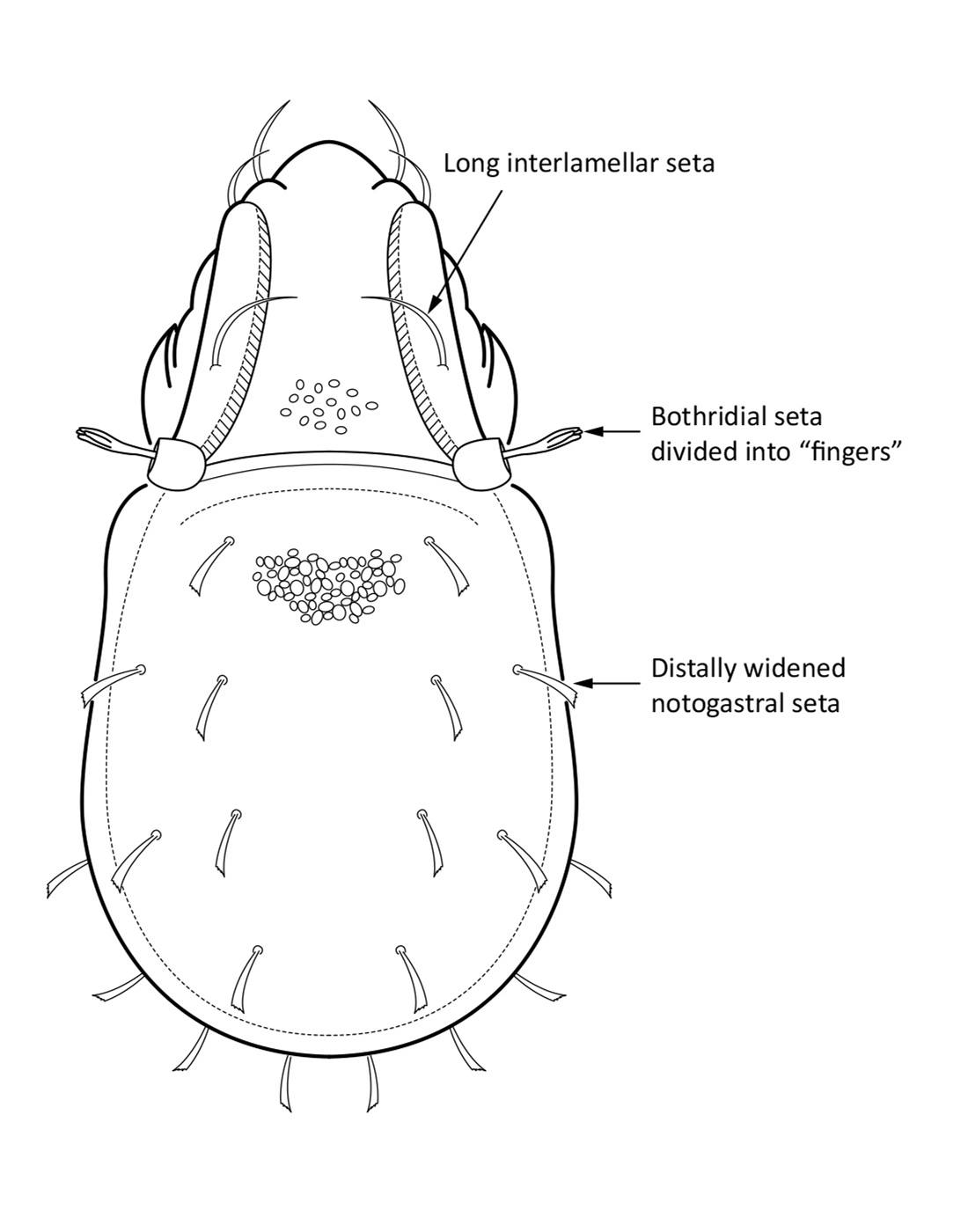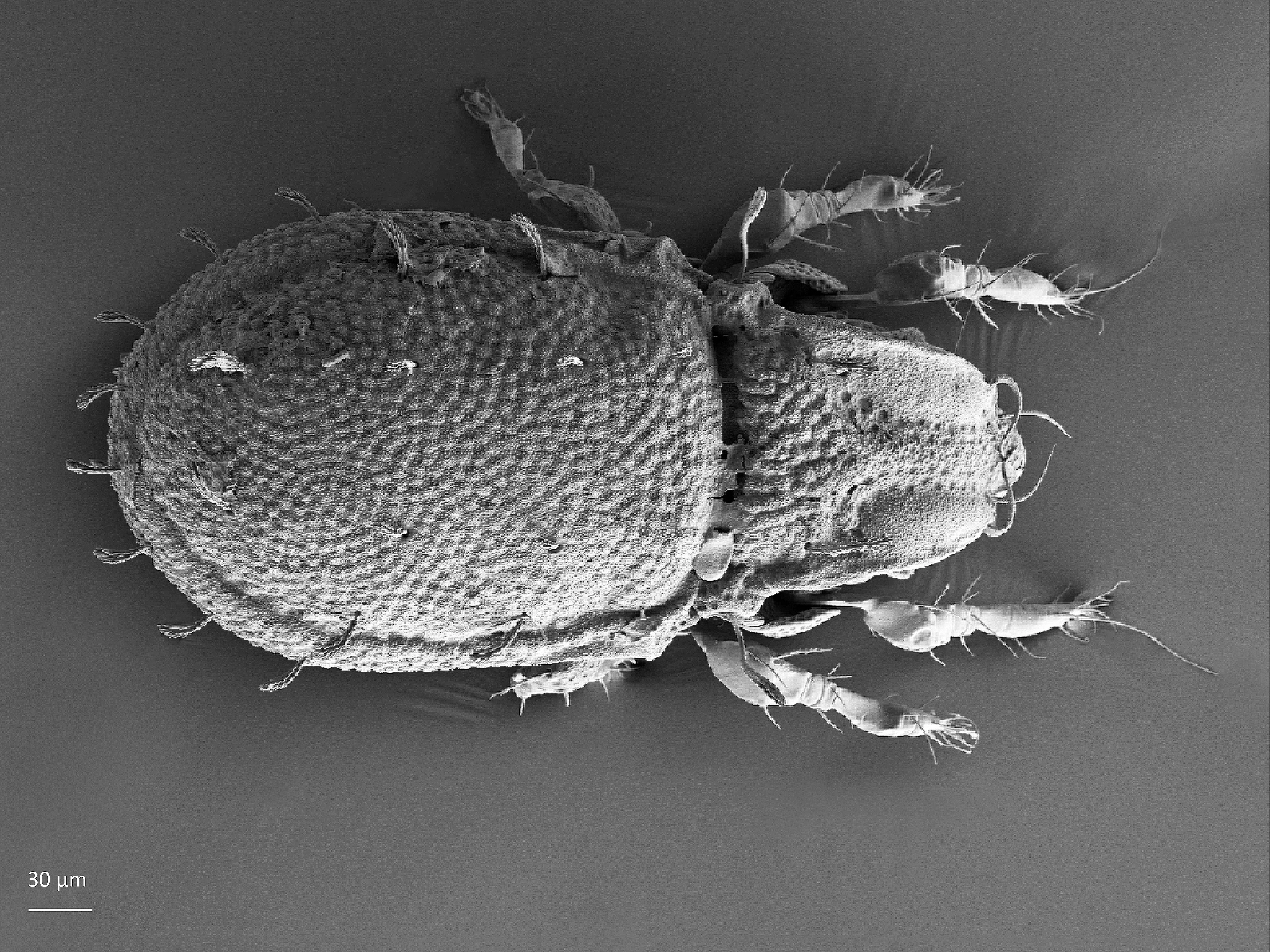Carabodes affinis
Carabodes affinis has an interesting distribution – it is considered a Mediterranean species, but has also been found in Ireland and Norway. It is a forest species, prevalently found in mosses. In Norway it is rare. Carabodes affinis has a sexual reproduction, but little is known about its biology.
Description

Fig. 1. Dorsal view of Carabodes affinis, adult.
Adult: The body length is 510 µm and width is 300 µm, and the body shape is rather elongated and oval. The color is reddish brown. A thin, granular waxy layer (cerotegument) covers the whole body (see cover photo). It has a regular cuticular microsculpture on the whole body surface. In the region of notogaster this microsculpture is composed of ridges delimiting rounded, irregular, more or less large areolae. There is a deep, wide depression (marked by arrowhead in Fig. 1) between the prodorsum and notogaster that is narrowing near the bothridia. Interlamellar and notogastral setae are narrowly clavate, erect, 5–6 times longer than wide. Bothridial setae are relatively short, directed upwards, narrowly clavate, they have relatively short stem and club-shaped head covered by short, thick cilia. The cuticular microsculpture between the ventral plates is deeply areolate.
Juvenile stages: unknown.
Look-alikes

Dorsal view of Carabodes areolatus, adult.
Carabodes affinis resembles C. areolatus Berlese, 1916, but it has short and narrowly clavate interlamellar seta on the prodorsum (similar to notogastral setae), while in C. areolatus this seta is long, slim and curved (Fig. 2). Carabodes affinis has bothridial seta with a short stem and club-shaped head covered by short thick cilia, while in C. areolatus this seta is divided into a few thick “fingers”. Also notogastral setae differ in shape in both species; they are narrowly clavate in C. affinis and distally widened in C. areolatus.
Biology
Carabodes affinis has a sexual reproduction, but little is known about its biology. Its development has not yet been studied, and also feeding preferences remain unknown.
Ecology
Distribution
Carabodes affinis has an interesting distribution – it is considered a Mediterranean species, but has also been found in Ireland and Norway.
Habitat
The species is silvicolous, found in different forest types, prevalently in mosses on ground, trees or stony walls, but also under tree bark, in forest canopy, humus or litter.
Findings in Norway
In Norway it is rare. It has been found only twice – in 1937 it was reported by Thor from Central Norway, and recently it was found in a broadleaf wet forest in Kvam in Western Norway. Among ca. 6000 oribatid mites examined, only two adult specimens of C. affinis were found in mosses growing on a stump.
References
Arroyo J, O'Connell T and Bolger T (2017). Oribatid mites (Acari: Oribatida) recorded from Ireland: Catalogue, historical records, species habitats and geographical distribution, combinations, variations and synonyms. Zootaxa 4328(1), 1–174.
Baratti M, Avanzati AM, Salomone N and Bernini F (1995). Taxonomic revision of Carabodes affinis Berlese, 1913 (Acari Oribatida Carabodidae). Notulae Oribatologicae LXVI. REDIA, 78(2), 331–348.
Subías LS (2004). Listado sistemático, sinonímico y biogeográfico de los ácaros oribátidos (Acariformes, Oribatida) del mundo (excepto fósiles). Graellsia 60 (número extraordinario), 3–305.
Thor S (1937). Übersicht der norwegischen Cryptostigmata mit einzelnen Neben bemerkungen. Nyt Magazin for Naturvidenskaberne 77(1), 275-307.
Weigmann G. (2006) Hornmilben (Oribatida). Die Tierwelt Deutschlands. 520 pp. Vol. 76, Goecke and Evers, Keltern.
Siden siteres som:
Seniczak A (2020). Carabodes affinis Berlese, 1913. www.artsdatabanken.no/Pages/286336. Nedlastet <dag/måned/år>
